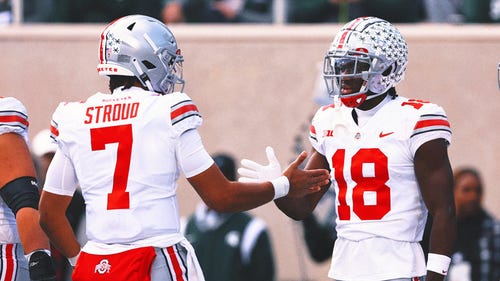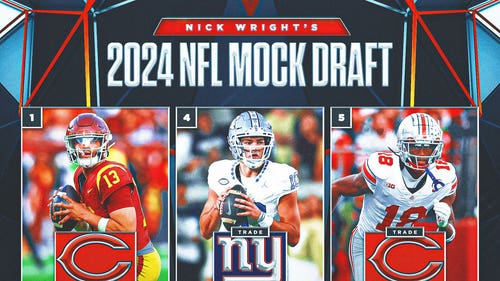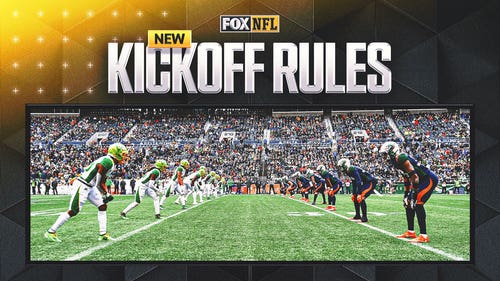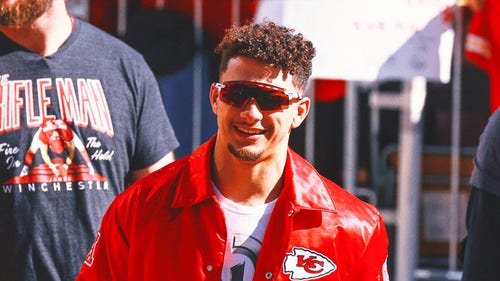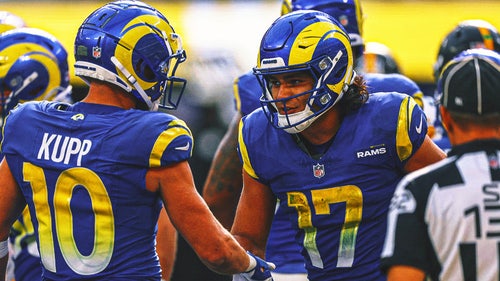
Analyzing potential Offensive Rookie of Year candidates

Rookies have begun signing their deals after the NFL Draft.
Now that we know who will be playing where and in what systems, we can begin to piece together how effective each player will be in his first season.
Since 1967, when The Associated Press NFL Offensive Rookie of the Year Award was first introduced, only 15 of the 47 recipients haven’t been running backs. With the game evolving into a passing league, wide receivers must now be considered more of a threat to win the award because of their prevalence in NFL offenses.
Of the 47 AP offensive rookies of the year, 32 have been running backs, eight have been wide receivers, and seven have been quarterbacks.
In 2013, the award came down to Packers running back Eddie Lacy and San Diego Chargers wide receiver Keenan Allen.
Comparing last year's contenders
| 2013 winner: Eddie Lacy | 284 rushing attempts |
1,178 yards | 11 TDs |
| 2013 runner-up: Keenan Allen | 71 receptions | 1,046 yards | 8 TDs |
While Allen posted some eye-popping numbers for a rookie wide receiver, Lacy put the Packers on his back while their franchise quarterback, Aaron Rodgers, was sidelined for eight weeks with a broken collarbone. During that eight-game span, Lacy powered his way to 666 yards and seven touchdowns on 151 carries, all while battling a lingering ankle injury. Lacy often faced eight-man boxes and notably watched film of Vikings running back Adrian Peterson when he faced similar defensive alignments.
"(Peterson) is very patient, but even with his patience he has great explosion," Lacy told reporters last November. "As soon as he finds it, he's hitting it like zero-to-60 really fast. I'm trying to work on the zero-to-60 part."
Lacy’s production tightened Green Bay’s grasp on the NFC North for the team's third consecutive division title.
Because the voters decide after the regular season, the recipients of the award in the past decade have been players who have come from winning teams or rewrote rookie history.
Bringing home the hardware
| 2013: Packers RB Eddie Lacy | Packers win NFC North |
| 2012: Redskins QB Robert Griffin III | Redskins win NFC East |
| 2011: Panthers QB Cam Newton | Most passing yards in rookie history |
| 2010: Rams QB Sam Bradford | Led Rams to 8-8 season |
| 2009: Vikings WR Percy Harvin | Vikings earn postseason berth |
| 2008: Falcons QB Matt Ryan | Falcons earn postseason berth |
| 2007: Vikings RB Adrian Peterson | Broke single-game rushing record |
| 2006: Titans QB Vince Young | Had 8-3 record as starter |
| 2005: Bucs RB Cadillac Williams | Bucs earn postseason berth |
| 2004: Steelers QB Ben Roethlisberger | Steelers win AFC North |
QUARTERBACKS
If any rookie quarterback leads his team to the postseason, the award is likely his. Looking at the five teams (Texans, Raiders, Browns, Jaguars, Vikings) that will potentially start a rookie quarterback, an overwhelming majority would agree that the Texans are the most ready to make a run into the postseason.
Browns quarterback Johnny Manziel will begin his career as a backup, according to team owner Jimmy Haslam, but it’s only a matter of time before he’s lining up underneath center Alex Mack. Manziel will create the most dazzling, highlight-reel plays of any rookie quarterback and will pique the national media’s interest on a week-by-week basis. If he proves to be an efficient passer from the pocket, paired with his exciting playmaking ability, he will win this honor in a landslide.
Vikings offensive coordinator Norv Turner’s plan is to spread the field for Adrian Peterson. When the eighth-year running back begins to produce, it will be quarterback Teddy Bridgewater picking apart the defense. Bridgewater ran a pro-style offense for three years under offensive coordinator Shawn Watson. Bridgewater ran a sophisticated, pro passing game and completed 71 percent of his passes (second best in the nation), while throwing 31 touchdowns with just four interceptions. Bridgewater must improve his deep-ball accuracy if he hopes to enjoy all of the perks Turner’s offense offers.
While Blake Bortles was selected No. 3 overall, it will be a challenge for a rookie quarterback to lead a team with a roster filled with question marks to a winning record.
The favorite: Johnny Manziel
The dark horse: Tom Savage
RUNNING BACKS
There are only a handful of running backs who are immediately set up to have an instant impact in Year One. Because most teams are adopting a multiple-back philosophy, Titans running back Bishop Sankey has a distinct edge on the other rookies at this position. Sankey, a well-rounded runner who displays a natural combination of power and speed, will consume a majority of the load in OTAs, as veteran running back Shonn Greene reportedly underwent knee surgery this offseason. If Sankey can prove to be an every-down back and assume the role Chris Johnson once played in Tennessee, he’ll rack up the yards, touchdowns and votes by The Associated Press. Additionally, the Titans used another first-round pick on an offensive lineman (Taylor Lewan) to pair with right guard Chance Warmack. If this line solidifies, it could pave some big lanes for the running backs.
The next batch of running backs will have veterans ahead of them on their respective depth charts and will see a limited amount of carries, short of some unpredictable occurrence.
BenJarvus Green-Ellis' future in Cincinnati is uncertain after the team spent a second-round pick on LSU product Jeremy Hill. While Green-Ellis is due only $2.3 million in base salary for 2014, second-year running back Giovani Bernard emerged as a go-to weapon. After eclipsing the 1,000-yard all-purpose mark, Bernard looks forward to new offensive coordinator Hue Jackson’s more traditional run-first play-calling. Could Hill be the early-down back, while Bernard plays the change-of-pace role? It’s a possibility.
The Rams rode Zac Stacy to 973 yards and seven touchdowns on the ground in 2013. They added former Auburn running back Tre Mason in the third round. Mason had plenty of production at the collegiate level, running for 1,816 yards and 23 touchdowns in 2014.
San Francisco’s Carlos Hyde, Cleveland’s Terrance West and Tampa Bay’s Charles Sims all will compete for playing time, but won’t be the lead runner in their systems as veterans and newly acquired free agents are slated to fill those roles.
The favorite: Bishop Sankey
The dark horse: Jeremy Hill
The wide receiver position in this year’s draft class was celebrated as one of the deepest in the past decade. Thirty-three wide receivers were drafted in 2014 -- the most since 2008 (35) -- but this position has one of the steepest learning curves in the league. Projecting production at the wide receiver position is a difficult task. Five wide receivers look to have an immediate impact in their team’s offenses.
Tampa Bay quarterback Josh McCown was lobbying for a large target outside the numbers for him on draft day. The team spent its No. 7 overall pick on former Texas A&M wide receiver Mike Evans. Evans mastered the jump ball in College Station in 2013, and he should have no problem pulling them down at the next level. Lined up opposite wide receiver Vincent Jackson, Evans will put added stress on a defense that will be forced to cover three players who stand 6-foot-5 or taller, including tight end Austin Seferian-Jenkins. In the six games McCown started for the Bears last season, he targeted Alshon Jeffery, the No. 2 option, 59 times, which was good for 37 receptions and four touchdowns. That equates to 98 receptions and 11 touchdowns over a full 16-game season. If Evans finished with such numbers, he’d be tough to pass up on the ballots.
Bills general manager Doug Whaley spent a 2015 first- and fourth-round draft pick to move up five slots to select Sammy Watkins. It’s no secret that it will be a priority for offensive coordinator Nathaniel Hackett to feature Watkins. With the addition of wide receiver Mike Williams via trade and Robert Woods gaining a year of experience last season, Watkins could see some favorable matchups from opposing defenses. Even if that’s not the case, he’s such a rare talent that he’ll continue to produce.
Catching on quickly:
| Rookie WR award winners |
Receptions | Yards | Touchdowns |
| Percy Harvin (2009) |
60 | 790 | 6 |
| Anquan Boldin (2003) | 101 | 1,377 | 8 |
| Randy Moss (1998) |
69 | 1,313 | 17 |
| Carl Pickens (1992) |
26 | 326 | 1 |
| Eddie Brown (1985) | 53 | 942 | 8 |
| Louis Lipps (1984) |
45 | 860 | 9 |
| Sammy White (1976) | 51 | 906 | 10 |
| Earl McCullouch (1968) |
40 | 680 | 5 |
The Broncos had four receivers (Demaryius Thomas, Eric Decker, Julius Thomas and Wes Welker) with 10 touchdowns or more in 2013. While Eric Decker left via free agency, Peyton Manning’s arsenal of weapons is never empty. By adding Emmanuel Sanders and drafting Cody Latimer, the 17-year quarterback won’t skip a beat. Latimer, who will reportedly be limited until training camp as he rehabs from a fractured fifth metatarsal, has experience in a spread offense. "He catches every ball that is within his radius," Indiana offensive coordinator Kevin Johns told USA TODAY Sports this month. "In three years, I can think of just one ball that he dropped."
Cam Newton’s wide receiver corps was absolutely decimated this offseason, but general manager Dave Gettleman got him a go-to weapon in Florida State product Kelvin Benjamin. While some consider Benjamin to be a one-year wonder, he has an 83-inch wingspan, which will assist in his transition into the next level.
The favorite: Mike Evans
The dark horse: Kelvin Benjamin







































































































































